The following layouts are expected to be at our 2025 exhibition. Click on any of the layout names to see pictures or videos of the layout.
 Ashfield (N, Chris Wardrop) is a fictional town on the Western Region, modelled in the 50s and 60s. The track plan is loosely based on Ashburton.
Ashfield (N, Chris Wardrop) is a fictional town on the Western Region, modelled in the 50s and 60s. The track plan is loosely based on Ashburton.
 Bigbury-on-Sea (OO, John Shaw) represents what might have been if the branch to Yealmpton, Devon, had been extended to the nearby seaside resort. In practice road competition caused the branch to close in 1931.
Bigbury-on-Sea (OO, John Shaw) represents what might have been if the branch to Yealmpton, Devon, had been extended to the nearby seaside resort. In practice road competition caused the branch to close in 1931.
 Brinklow (N, Milton Keynes MRC) is based on the Trent Valley Line which opened in 1847 and is now part of the west coast main line. The model depicts the 50s and 60s, and includes the Oxford canal which runs close to the line at this point.
Brinklow (N, Milton Keynes MRC) is based on the Trent Valley Line which opened in 1847 and is now part of the west coast main line. The model depicts the 50s and 60s, and includes the Oxford canal which runs close to the line at this point.
 Brixcombe (P4) F&D MRC. A new board we are adding to our existing club layout to extend it past the station with a line leading to a quay, and a narrow gauge feeder line from a quarry with dual gauge track.
Brixcombe (P4) F&D MRC. A new board we are adding to our existing club layout to extend it past the station with a line leading to a quay, and a narrow gauge feeder line from a quarry with dual gauge track.
 Cadhay Sidings (P4, Chris Gough) is a Southern Railway branch line in the 1930s. It models the Sidmouth branch with a fictitious set of sidings by the real Cadhay Crossing to serve a couple of industries. It is worked prototypically with Single Line Token, Bell Signals, Block Instruments and full signalling.
Cadhay Sidings (P4, Chris Gough) is a Southern Railway branch line in the 1930s. It models the Sidmouth branch with a fictitious set of sidings by the real Cadhay Crossing to serve a couple of industries. It is worked prototypically with Single Line Token, Bell Signals, Block Instruments and full signalling.
 Chwarel Tegid (OO9, Tim Williams) is a representation of some aspects of slate quarry operation. It might be an operating quarry in the 50s, or it could be present day mining museum. The two main features are the operating slate incline and the inclined ropeway.
Chwarel Tegid (OO9, Tim Williams) is a representation of some aspects of slate quarry operation. It might be an operating quarry in the 50s, or it could be present day mining museum. The two main features are the operating slate incline and the inclined ropeway.
 Clyre Valley Railway (OO9, Tim Couling) represents a 2’3” main line narrow gauge railway, not in the first flush of youth, but well maintained and capable of handling fairly heavy traffic. Set in Cornwall the railway handles significant mineral traffic, in this case China Clay, as well as healthy passenger and general goods traffic.
Clyre Valley Railway (OO9, Tim Couling) represents a 2’3” main line narrow gauge railway, not in the first flush of youth, but well maintained and capable of handling fairly heavy traffic. Set in Cornwall the railway handles significant mineral traffic, in this case China Clay, as well as healthy passenger and general goods traffic.
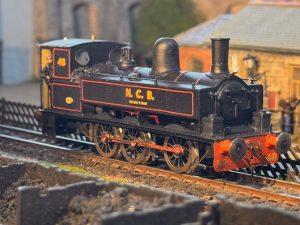 Fence Houses NCB (OO, Ian Forsyth) models a busy National Coal Board (NCB) shed in the industrial North East to the south west of Sunderland. It is mainly a NCB site, but empty and full coal wagons are transferred to and from the BR system. The line at the back of the layout is a shared user line with BR and this is the only line BR locomotives are allowed to use. Many of the materials needed to run a coal mine and its industries are also supplied by rail, so steel beams, pipes and more will arrive at the small yard.
Fence Houses NCB (OO, Ian Forsyth) models a busy National Coal Board (NCB) shed in the industrial North East to the south west of Sunderland. It is mainly a NCB site, but empty and full coal wagons are transferred to and from the BR system. The line at the back of the layout is a shared user line with BR and this is the only line BR locomotives are allowed to use. Many of the materials needed to run a coal mine and its industries are also supplied by rail, so steel beams, pipes and more will arrive at the small yard.
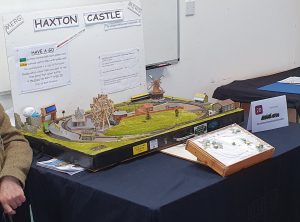 Haxton Castle (N, John Wilson) is a computer controlled, push button operated layout, with various animations. It was made for children aged from 5 to 95. It uses many different MERG (Model Electronics Railway Group) electronic kits to automate features.
Haxton Castle (N, John Wilson) is a computer controlled, push button operated layout, with various animations. It was made for children aged from 5 to 95. It uses many different MERG (Model Electronics Railway Group) electronic kits to automate features.
 Hazelbury Junction (OO, F&D MRC) depicts a station on a busy main line with its platforms situated on loops so as to allow express trains to pass local trains that are standing at the platforms. The station is the terminus of the branch line to Greystone End and the branch has its own platform alongside the main line Down platform. The Station has a Goods Shed to handle the goods traffic generated by the local brewery and other local industries and a coal yard to serve the Hazelbury Town population. There is a two row Engine Shed with its associated ash and coaling facilities for the freight locos calling at the yard.
Hazelbury Junction (OO, F&D MRC) depicts a station on a busy main line with its platforms situated on loops so as to allow express trains to pass local trains that are standing at the platforms. The station is the terminus of the branch line to Greystone End and the branch has its own platform alongside the main line Down platform. The Station has a Goods Shed to handle the goods traffic generated by the local brewery and other local industries and a coal yard to serve the Hazelbury Town population. There is a two row Engine Shed with its associated ash and coaling facilities for the freight locos calling at the yard.
 Llawryglyn (EM, Richard Loydall) is a plausible representation of the passenger terminus of a Cambrian railways branch off the real Cambrian line from Caersws to Van to Llawrglyn, which does exist but never had a railway. The goods shed is a model of the one at Dinal Mawdddwy.
Llawryglyn (EM, Richard Loydall) is a plausible representation of the passenger terminus of a Cambrian railways branch off the real Cambrian line from Caersws to Van to Llawrglyn, which does exist but never had a railway. The goods shed is a model of the one at Dinal Mawdddwy.
 McDermott’s Machinery (N Fine, Neil Watson) was inspired by a 4mm layout called Daisy Dairy. The point, single outside slip and track are hand laid using Code 40 rail and copper clad sleepers. Templot was used to de-sign the trackwork. The point and uncoupler servos are driven by MERG electronics and can be operated via a tablet using JMRI as the interface. Track power is via MERG DCC.
McDermott’s Machinery (N Fine, Neil Watson) was inspired by a 4mm layout called Daisy Dairy. The point, single outside slip and track are hand laid using Code 40 rail and copper clad sleepers. Templot was used to de-sign the trackwork. The point and uncoupler servos are driven by MERG electronics and can be operated via a tablet using JMRI as the interface. Track power is via MERG DCC.
 Much Murkle (OO, Nick Wood) is set in a fictitious 1930s community in Herefordshire served by a single line branch. There is a rail served quarry about a mile outside Much Murkle, all trains departing the quarry have to be reversed at the terminus as the quarry has no run round loop.
Much Murkle (OO, Nick Wood) is set in a fictitious 1930s community in Herefordshire served by a single line branch. There is a rail served quarry about a mile outside Much Murkle, all trains departing the quarry have to be reversed at the terminus as the quarry has no run round loop.
 Neuberg Project (HOm, Jim Finlayson) is a fictional location on the metre gauge Swiss Rhaetian Railway. There are two models of the same place, one depicting the railway in 1913 and the other in 2013, showing the evolution of the railway from steam to electric.
Neuberg Project (HOm, Jim Finlayson) is a fictional location on the metre gauge Swiss Rhaetian Railway. There are two models of the same place, one depicting the railway in 1913 and the other in 2013, showing the evolution of the railway from steam to electric.
 North Quay (2mm FS, Ian Morgan)
North Quay (2mm FS, Ian Morgan)
North Quay at St. Helens on the Isle of Wight was a spur off the Brading to Bembridge branch of the Isle of Wight Railway, which closed to passengers in 1953 and completely in 1957.
 Northport Quay (7mm Irish BG, David Holman) is a model of the Irish 5′ 3″ gauge in 7mm scale on 36.45mm gauge. The setting is somewhere in the northwest of Ireland. It has a small station and a harbour with fish traffic and a coaster based on a Clyde Puffer.
Northport Quay (7mm Irish BG, David Holman) is a model of the Irish 5′ 3″ gauge in 7mm scale on 36.45mm gauge. The setting is somewhere in the northwest of Ireland. It has a small station and a harbour with fish traffic and a coaster based on a Clyde Puffer.
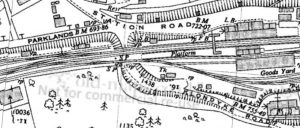 Okehampton (N Fine, F&D MRC) is the new club N Gauge layout we are building. One of the 7 boards will be on display, containing the station, goods shed, and the Magnorail moving vehicle system.
Okehampton (N Fine, F&D MRC) is the new club N Gauge layout we are building. One of the 7 boards will be on display, containing the station, goods shed, and the Magnorail moving vehicle system.
 Plumpton Green (P4, Barry Luck) is based on Plumpton, a small settlement between Lewes and Ditching in East Sussex, the station served Plumpton race course. It is modelled as it was 1900-1914 with some small changes. It is controlled by a fully interlocked mechanical lever frame.
Plumpton Green (P4, Barry Luck) is based on Plumpton, a small settlement between Lewes and Ditching in East Sussex, the station served Plumpton race course. It is modelled as it was 1900-1914 with some small changes. It is controlled by a fully interlocked mechanical lever frame.
 Port Jubilee (2mm FS, Anthony Yeates) is a rail served pier somewhere on the Scottish coast set in the Edwardian era. It has an oval baseboard. The track plan is the classic Inglenook shunting puzzle track plan, with three sidings capable of holding 5, 3, and 3 wagons.
Port Jubilee (2mm FS, Anthony Yeates) is a rail served pier somewhere on the Scottish coast set in the Edwardian era. It has an oval baseboard. The track plan is the classic Inglenook shunting puzzle track plan, with three sidings capable of holding 5, 3, and 3 wagons.
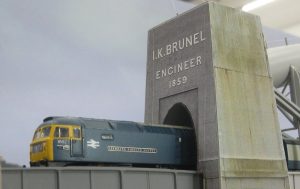 Royal Albert Bridge (N, Basingstoke MRC) is a representation of the Royal Albert Bridge which spans the River Tamar between Devon and Cornwall. It is not fully to scale as it was built to fit within the limits of a baseboard for a competition. Except for the plate girder bridge sides, the bridge is totally scratch built from Plastikard, Plastruct, Microstrip, water pipe, card, paper and a Pringles tube. The higher level main running line over the bridge is N-gauge and the lower lines to Okehampton and in the dockside area are to 2mm Finescale standards.
Royal Albert Bridge (N, Basingstoke MRC) is a representation of the Royal Albert Bridge which spans the River Tamar between Devon and Cornwall. It is not fully to scale as it was built to fit within the limits of a baseboard for a competition. Except for the plate girder bridge sides, the bridge is totally scratch built from Plastikard, Plastruct, Microstrip, water pipe, card, paper and a Pringles tube. The higher level main running line over the bridge is N-gauge and the lower lines to Okehampton and in the dockside area are to 2mm Finescale standards.
 Rydes Vale (2mm FS, Simon Humphries) is part of a historic layout first exhibited in 1961 at the Central Hall, Westminster. It was one of the first layouts in this scale to be exhibited, before N gauge was invented. It was built by Bert Groves, one of the founders of the 2mm Scale Association. It has been stored in a loft since 1969 but is now being restored. The engine shed board will be at the exhibition along with a selection of the original locomotives with hand made motors (nothing that small was available then). Despite being over 60 years old they will be some of the smoothest running locos at the exhibition!
Rydes Vale (2mm FS, Simon Humphries) is part of a historic layout first exhibited in 1961 at the Central Hall, Westminster. It was one of the first layouts in this scale to be exhibited, before N gauge was invented. It was built by Bert Groves, one of the founders of the 2mm Scale Association. It has been stored in a loft since 1969 but is now being restored. The engine shed board will be at the exhibition along with a selection of the original locomotives with hand made motors (nothing that small was available then). Despite being over 60 years old they will be some of the smoothest running locos at the exhibition!
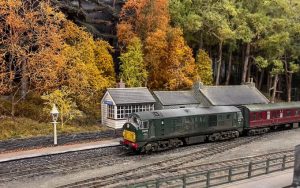 Tellindaloch (OO, Terence Tew) is set in North East Scotland and is the terminus of a fictitious ex-Great North of Scotland Railway branch line. Situated at the front of the layout is the entrance to a Whisky Distillery. Most of the buildings are scratchbuilt, including the very typical GNSR goods shed and signal box, and the station building is loosely based on the one at Carron. All the 70-plus trees of various sizes on the layout have been handmade.
Tellindaloch (OO, Terence Tew) is set in North East Scotland and is the terminus of a fictitious ex-Great North of Scotland Railway branch line. Situated at the front of the layout is the entrance to a Whisky Distillery. Most of the buildings are scratchbuilt, including the very typical GNSR goods shed and signal box, and the station building is loosely based on the one at Carron. All the 70-plus trees of various sizes on the layout have been handmade.
 Tucking Mill + William Smith’s Wharf (2mm FS, Jerry Clifford) is a fictitious railway set in a real location just south of Bath, joining the S&DJR. It depicts the station as it might have looked in the 1920s with freight receipts just about in profit and the meagre passenger service hanging on by its fingernails. The former flock mill now serves the Fullers Earth works whose products are despatched all over the country, the siding superseding the adjacent, and rapidly silting up, Somerset Coal canal. There is a gated siding to a wharf from where high-quality Oolitic limestone is loaded. The Bath stone, which is brought down by tramway from quarries up on Combe Down, is in great demand for buildings in London and elsewhere.
Tucking Mill + William Smith’s Wharf (2mm FS, Jerry Clifford) is a fictitious railway set in a real location just south of Bath, joining the S&DJR. It depicts the station as it might have looked in the 1920s with freight receipts just about in profit and the meagre passenger service hanging on by its fingernails. The former flock mill now serves the Fullers Earth works whose products are despatched all over the country, the siding superseding the adjacent, and rapidly silting up, Somerset Coal canal. There is a gated siding to a wharf from where high-quality Oolitic limestone is loaded. The Bath stone, which is brought down by tramway from quarries up on Combe Down, is in great demand for buildings in London and elsewhere.
 Ulvaryd (Strand) (HOe, Charles Insley) is freelance based on the Swedish 60 cm gauge railways that existed until the early 1950s. It is set in southern Sweden on the shores of lake Vattern. The railway was built in the early 20th century and began its life with imported French locomotives, some of which are still in service.
Ulvaryd (Strand) (HOe, Charles Insley) is freelance based on the Swedish 60 cm gauge railways that existed until the early 1950s. It is set in southern Sweden on the shores of lake Vattern. The railway was built in the early 20th century and began its life with imported French locomotives, some of which are still in service.
 Worton Court (O16.5, Geoff Thorne) started life as part of the Cottesmore Light Railway built by the Twickenham club and first exhibited in 1979. After 20 years in storage in a loft it had deteriorated, and in 2012 it was decided to revive it. It was exhibited in its new form in 2014, and since then additional sections have been added. It depicts an estate railway providing a link between the main house, the estate, a mine, and the outside world.
Worton Court (O16.5, Geoff Thorne) started life as part of the Cottesmore Light Railway built by the Twickenham club and first exhibited in 1979. After 20 years in storage in a loft it had deteriorated, and in 2012 it was decided to revive it. It was exhibited in its new form in 2014, and since then additional sections have been added. It depicts an estate railway providing a link between the main house, the estate, a mine, and the outside world.
 The Yard (O & On16.5, Martin Coombs) represents the corner of a large factory in SE England. Materials arrive by rail and lorry, and are transferred to the narrow gauge works railway by a crane. The crane is fully working and the lorries are radio controlled.
The Yard (O & On16.5, Martin Coombs) represents the corner of a large factory in SE England. Materials arrive by rail and lorry, and are transferred to the narrow gauge works railway by a crane. The crane is fully working and the lorries are radio controlled.
 200 Years of Railways (OO, F&D MRC) shows the evolving designs of locomotives from steam to diesel using OO model examples provided by members of the club. As each travels along the scenic portion of track displays will show historical and other relevant facts.
200 Years of Railways (OO, F&D MRC) shows the evolving designs of locomotives from steam to diesel using OO model examples provided by members of the club. As each travels along the scenic portion of track displays will show historical and other relevant facts.
 Charity Layout (N, F&D MRC). Once again club members are building a layout that will be raffled at the show charity, complete with a few trains, in aid of the Aldershot charity Step by Step which helps young people going through hard times.
Charity Layout (N, F&D MRC). Once again club members are building a layout that will be raffled at the show charity, complete with a few trains, in aid of the Aldershot charity Step by Step which helps young people going through hard times.

